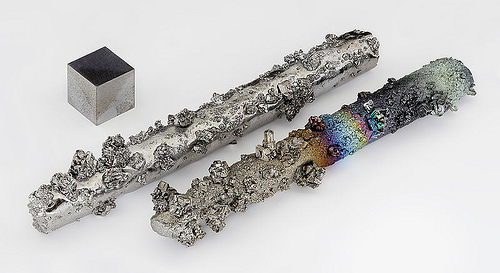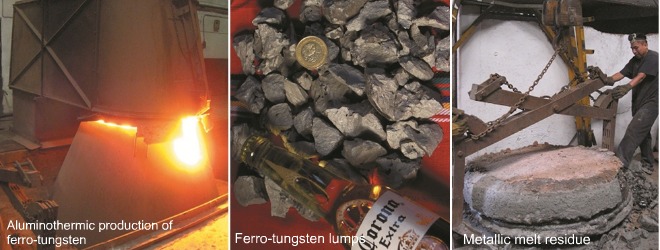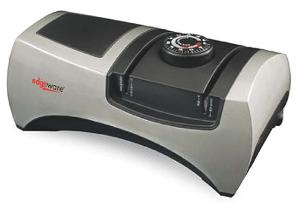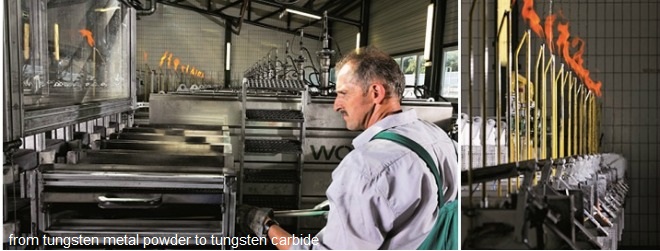Tungsten
- Details
- Category: Tungsten Information
- Published on Saturday, 05 January 2013 13:51
- Hits: 3311

Tungsten rods with evaporated crystals, partially oxidized with colorful tarnish. Purity 99.98 %, as well as a high pure (99.999 % = 5N) 1 cm3 tungsten cube for comparison.
This element tungsten, which has the chemical symbol W and the atomic number 74. The name is derived from Swedish and translates as "heavy stone", in recognition of one of this metal's more obvious qualities.
Pure tungsten is silver-coloured, very hard, and has an extremely high melting point (3422 °C / 6192 °F) -- the highest for any metal and second only to carbon (3550°C / 6422°F). Tungsten is quite rare on Earth and occurs in the wild only in a number of minerals.
By now, I suppose that you are wondering where the chemical symbol, W, came from. Although this element is known as tungsten in many English and French speaking countries, a number of European countries know it as wolfram, a word derived from German, which translates roughly as "wolf's froth" or "cream" -- a reference to the large amounts of tin consumed by tungsten extraction.
Lighting the Way in Reducing Greenhouse Gas Emissions
- Details
- Category: Tungsten Information
- Published on Saturday, 05 January 2013 10:15
- Hits: 2996
Recycling, reusing and reducing are all ways in which Europeans are assisting in efforts to reduce greenhouse gas (GHG) emissions. It is a far cry from the days when we threw everything away without thought. Now we know it is the simple solutions that are making the difference. One example is lighting, which accounts for 14 % of electricity consumption in the EU. As a result, incandescent bulbs are being phased out in Europe and replaced with new energy-efficient and eco-friendly lighting technologies.
The EU has committed to cutting its GHG emissions by at least 20 % by 2020 and to improving energy efficiency also by 20 %. As part of this effort, the European Commission launched its Green Paper on 'Lighting the Future - Accelerating the deployment of innovative lighting technologies'. This in turn is raising awareness of the benefits of light-emitting diode (LED).
This Green Paper is part of the Digital Agenda under the Europe 2020 strategy for smart, sustainable and inclusive growth. It sets out the key issues to be addressed in a European strategy aimed at accelerating the deployment of high-quality solid state lighting (SSL) for general lighting. Its main objective is to help Europe achieve its key energy efficiency, industrial and innovation policy objectives.
Read more: Lighting the Way in Reducing Greenhouse Gas Emissions
[Knowledge of Tungsten Products] Ferro-Tungsten & Melting Base
- Details
- Category: Tungsten Information
- Published on Thursday, 27 December 2012 10:15
- Hits: 3062
Ferro-Tungsten
Ferro-tungsten is a master alloy for the production of tungsten-containing steels. The raw materials for ferro-tungsten production are rich ore or ore concentrates of wolframite or scheelite. Also artificial scheelite or soft scrap can be used. The tungsten trioxide in these compounds can be reduced either carbothermically in electric arc furnaces or metallothermically by silicon and/or aluminum. Also a mixed carbothermic-silicothermic production is in use.
Commercial ferro-tungsten contains between 75 and 85% W. It has a steel grey appearance and a fine-grained structure consisting of FeW and Fe2W. It is supplied in 80–100 mm lumps.
Melting Base
Melting Base is another master alloy in tungsten steel production. It can have various compositions according to the tungsten scrap material in use. The tungsten content varies depending on type between 10 and 38% besides iron and sometimes 5.5% Mo and also 5 to 10% Co.
Different types of scrap materials are mixed to meet the required composition. Reductive melting is done in electric arc furnaces and the melt is finally granulated by casting on a rotating disc and quenching in water (size <10 mm).

Tungsten Manufacturer & Supplier: Chinatungsten Online - http://www.chinatungsten.com
Tel.: 86 592 5129696; Fax: 86 592 5129797
Email: sales@chinatungsten.com
PC Version: Tungsten News & Tungsten Prices: http://news.chinatungsten.com
3G Version :Tungsten News & Tungsten Prices : http://3g.chinatungsten.com
WML Version:Tungsten News & Tungsten Prices: http://m.chinatungsten.com
Smart Shopper: Knife Sharpeners
- Details
- Category: Tungsten Information
- Published on Saturday, 05 January 2013 09:48
- Hits: 3037
Few tools are as invaluable to a chef as the right knife. And, to ensure that the tool keeps its cutting edge, a knife sharpener is equally important. Sharpeners come in both manual and electric models.
An electric knife sharper is better for knives used to cut bones or frozen foods,  where a razor edge isn't needed. A manual sharpener will give a precise cutting edge for foods such as meats and tomatoes. Some models offer both manual and electric sharpening.
where a razor edge isn't needed. A manual sharpener will give a precise cutting edge for foods such as meats and tomatoes. Some models offer both manual and electric sharpening.
An ideal knife sharpener starts with a hard, abrasive surface - such as diamond, tungsten carbide or high-alumina ceramic - then uses steel or other ceramics for polishing. Sharpeners made of diamond or tungsten carbide tend to be more expensive; they sharpen quickly but pose a danger to some metals. Among manual models, butcher's steel and ceramic sticks are good for everyday use. For precision in a manual model, look for one made with diamond, tungsten carbide or whetstone. Stone sharpeners, safe for most knives, wear out over time.
[Knowledge of Tungsten Products] Tungsten Carbide Powder
- Details
- Category: Tungsten Information
- Published on Thursday, 27 December 2012 10:12
- Hits: 3003
Tungsten carbide powder is the intermediate in the line from W powder to cemented carbides. It can be produced from different raw materials and by different processes. By far the biggest percentage is manufactured by the conventional method - carburization of tungsten powder - and covers the widest range of powder qualities in regard to average particle size (0.15–12µm). All other methods in use yield very fine or very coarse powder grades.
The conventional process of carburisation comprises mixing of the respective tungsten powder of desired particle size with high purity carbon (lamp black or graphite) and reacting at temperatures between 1,300 to 1,600°C in hydrogen atmosphere. The average particle size and particle size distribution of the original tungsten powder determine size and distribution of the WC powder.
The final carbon content of the WC Powder depends on the production mode of the hardmetal producer and is one item of the rigid specification, and varies from slightly sub-stoichiometric to stoichiometric (6.13% C) to slightly over-stoichiometric. But not only is the carbon content specified but also a series of physical properties including: average particle size, particle size distribution, apparent (bulk) density and homogeneity.
High temperature carburised WC powders (1,700–2,200 °C) are usually coarse 10 to 50µm, but sometimes also 5 to 10µm grades are treated that way. The percentage of high temperature WC is small.
Tungsten carbide powder is packaged in sealed polyethylene-lined steel drums.

Tungsten Manufacturer & Supplier: Chinatungsten Online - http://www.chinatungsten.com
Tel.: 86 592 5129696; Fax: 86 592 5129797
Email: sales@chinatungsten.com
PC Version: Tungsten News & Tungsten Prices: http://news.chinatungsten.com
3G Version :Tungsten News & Tungsten Prices : http://3g.chinatungsten.com
WML Version:Tungsten News & Tungsten Prices: http://m.chinatungsten.com





 sales@chinatungsten.com
sales@chinatungsten.com